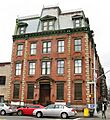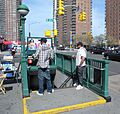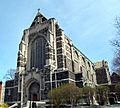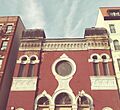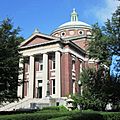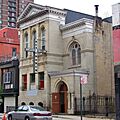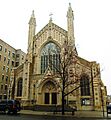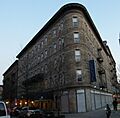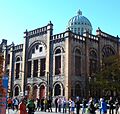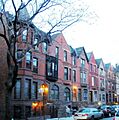National Register of Historic Places listings in Manhattan above 110th Street facts for kids
The National Register of Historic Places is like a special list of important buildings, places, and areas in the United States. These places are chosen because they have a lot of history, special architecture, or are important to how our country developed. When a place is on this list, it means it's recognized as a valuable part of our past and should be protected.
This article is about the amazing historic places in Manhattan, New York City, specifically those located north of 110th Street. This area includes neighborhoods like Harlem, Washington Heights, and Morningside Heights. You can see where these places are on a map by clicking "Map of all coordinates" at the top of the original page.
Contents
Historic Places Above 110th Street
Many buildings and areas in Upper Manhattan are on the National Register. They tell stories about the city's past, from old police stations to famous homes and important subway stops.
Cool Buildings and Homes
- The 32nd Police Precinct Station House Complex (1850-1854 Amsterdam Avenue) in Harlem is an old police station built in the 1870s. It shows how policing changed back then. Today, it's used by community groups.
- The 369th Regiment Armory (2366 Fifth Avenue) in Harlem was the home of the famous 369th Regiment, also known as the Harlem Hellfighters. They were a brave African-American military unit in World War I.
- The Ansche Chesed Synagogue (1883 Adam Clayton Powell Jr. Blvd.) in Harlem was once one of the biggest synagogues in the country. Now, it's the Mount Neboh Baptist Church.
- The Apollo Theater (253 W. 125th St.) in Harlem is a super famous place where many African-American musicians performed in the mid-1900s. It's a landmark for music history!
- The James Bailey House (10 St. Nicholas Pl.) in Harlem is another historic home.
- The Old Broadway Synagogue (15 Old Broadway) in Harlem is a historic place of worship.
- The Calvary Methodist Episcopal Church (211 W. 129th St.) in Harlem was once the largest church in New York City when it was built in 1887. Later, it became the Salem United Methodist Church.
- The Casa Italiana (1151-1161 Amsterdam Ave.) is part of Columbia University in Morningside Heights.
- The Chapel of the Intercession Complex and Trinity Cemetery (550 W. 155th St.) in Washington Heights is a beautiful church and cemetery.
- The Church of Notre Dame and Rectory (405 W. 114th St.) in Morningside Heights is another historic church.
- The College of the City of New York (bounded by Amsterdam Ave., St. Nicholas Terr., W. 138th, and W. 140th Sts.) in Upper Manhattan is a historic college campus.
- The Congregation Shaare Zedek of Harlem (23 W. 118th St.) is a 1901 synagogue that now serves the local African-American community as a Protestant church.
- The Croton Aqueduct Gate House (135th St. and Convent Ave.) in Upper Manhattan was part of the city's old water system.
- The Delta Psi, Alpha Chapter (434 Riverside Dr.) is a historic building in Morningside Heights.
- The Dunbar Apartments (bounded by 7th and 8th Aves. and W. 149th and 150th Sts.) in Harlem are important historic apartments.
- The William Dyckman House (4881 Broadway) in Inwood is the very last farmhouse left in Manhattan! It dates back to the late 1700s and is now a museum.
- Earl Hall (2980 Broadway) at Columbia University in Morningside Heights was built in 1902. It's famous for housing the first student LGBT organization in the U.S.
- The Elmendorf Reformed Church (171 E. 121st St.) in Harlem is a historic church building.
- The Fire Hook and Ladder Company No. 14 (120 E. 125th St.) in Harlem is an old fire station that now houses the Caribbean Cultural Center African Diaspora Institute.
- The First African Methodist Episcopal Church, Bethel (60 W. 132nd St.) in Harlem is a very important black church. Marcus Garvey gave his first Harlem speech here.
- The Fort Washington Avenue Armory (216 Fort Washington Ave.) in Washington Heights is a large building from 1911. It's now home to the National Track and Field Hall of Fame.
- The Fort Washington Presbyterian Church (21 Wadsworth Ave.) in Washington Heights is another historic church.
- The Fourth Church of Christ, Scientist (551 Ft. Washington Ave.) in Washington Heights is a historic religious building.
- The General Grant National Memorial (Riverside Dr. and W. 122nd St.) in Morningside Heights is the tomb of President Ulysses S. Grant.
- The Hamilton Grange National Memorial (414 W. 141st Street) in Hamilton Heights was the home of Alexander Hamilton, one of America's Founding Fathers. It was recently moved to protect it.
- The Harlem Courthouse (170 E. 121st St.) in Harlem is a historic government building.
- The Harlem Fire Watchtower (Marcus Garvey Park at E. 122nd St.) in Harlem is the only one left of 11 fire watchtowers that used to cover Manhattan. It was used to spot fires from above!
- The Harlem River Houses (151st to 153rd St., Macombs Pl. and Harlem River Dr.) in Harlem are historic housing projects.
- The Harlem Savings Bank (124 E. 125th St.) in Harlem is a historic bank building.
- The Matthew Henson Residence (246 W. 150th St., Apt. 3F) in Harlem was the home of Matthew Henson, a famous African-American explorer who was one of the first people to reach the North Pole.
- The High Bridge Aqueduct and Water Tower (Harlem River at W. 170th St.) in Washington Heights is an old bridge and water tower.
- The Hispanic Society of America Complex (613 W. 155th St.) in Washington Heights is a group of buildings dedicated to Spanish and Portuguese art and culture.
- The Holy Cross African Orthodox Pro-Cathedral (122 W. 129th St.) in Harlem is the first and only cathedral of the African Orthodox Church.
- The Holyrood Protestant Episcopal Church (715 West 179th St.) in Washington Heights is a historic church.
- The Hotel Theresa (2082-2096 Adam Clayton Powell, Jr. Blvd.) in Harlem is a famous hotel that was important during the Civil Rights Movement.
- The Hudson View Gardens (116 Pinehurst Ave.) in Hudson Heights was the largest housing cooperative in the U.S. when it was built in the 1920s.
- The Langston Hughes House (20 E. 127th St.) in Harlem was the home of Langston Hughes, a very important African-American poet and writer.
- The International House (500 Riverside Dr.) in Morningside Heights is a place where students from all over the world live and learn together.
- The Ivey Delph Apartments (17-19 Hamilton Terrace) in Hamilton Heights are historic apartments.
- The Jeffrey's Hook Lighthouse (Fort Washington Park) in Washington Heights is famously known as the Little Red Lighthouse because it sits under the giant George Washington Bridge.
- The James Weldon Johnson House (187 W. 135th St.) in Harlem was the home of James Weldon Johnson, a writer and civil rights activist.
- The Low Memorial Library, Columbia University (W. 116th St. between Broadway and Amsterdam Ave.) in Morningside Heights is the largest granite-domed building in the U.S. It's now Columbia's main administration building.
- The Claude McKay Residence (180 W. 135th St.) in Harlem is also known as the Harlem YMCA.
- The Milbank, Brinckerhoff, and Fiske Halls (bounded by W. 119th and W. 120th Sts., and Broadway and Claremont Aves.) are historic buildings at Barnard College in Morningside Heights.
- Minton's Playhouse (206-210 W. 118th St.) in Harlem is a famous jazz club.
- The Morris-Jumel Mansion (160th St. and Edgecombe Ave.) in Washington Heights is the oldest house in Manhattan!
- The Mount Morris Bank (E. 125th St. and Park Ave.) in Harlem is a historic bank building.
- The New York Amsterdam News Building (2293 7th Ave.) in Harlem was once the offices of the New York Amsterdam News, an important African-American newspaper.
- The New York Presbyterian Church (151 W. 128th St & 7th Ave.) in Harlem is now known as the Metropolitan Baptist Church.
- The National Headquarters, March on Washington for Jobs and Freedom (170 W. 130th St.) in Harlem is a townhouse where the famous 1963 civil rights march, where Martin Luther King Jr. gave his "I Have a Dream" speech, was planned.
- The New York Public Library, 115th Street Branch (203 W. 115th St.) in Harlem is a historic library building.
- The New York Public Library, Fort Washington Branch (535 West 179th St.) in Washington Heights is another historic library.
- The New York Public Library, Hamilton Grange Branch (503 and 505 W. 145th St.) in Washington Heights is also a historic library.
- The North Presbyterian Church (525 W. 155th St.) in Washington Heights is a historic church.
- The Park and Tilford Building (310 Lenox Ave.) in Harlem is a historic building.
- Philosophy Hall (1150 Amsterdam Avenue) at Columbia University in Morningside Heights is where Edwin Howard Armstrong invented FM radio in a basement lab!
- Public School 157 (327 St. Nicholas Ave.) in Harlem is a historic school building.
- Pupin Physics Laboratories, Columbia University (Broadway and 120th St.) in Morningside Heights is where the first successful atom splitting on U.S. soil happened in a basement lab!
- The Riverside Church (478, 490 Riverside Dr. & 81 Claremont Ave.) in Morningside Heights was established in 1930 and is known for its role in social and political activism. Its 392-foot tower makes it the tallest church in the U.S.
- The Paul Robeson Home (555 Edgecombe Ave.) in Washington Heights was the home of Paul Robeson, a famous singer, actor, and civil rights activist.
- St. Andrew's Episcopal Church (2067 5th Ave.) in Harlem is a historic church.
- St. Luke's Hospital (30 Morningside Drive) in Morningside Heights is a complex of 11 buildings that show how large city hospitals changed over time.
- St. Philip's Church (210-216 West 134th St.) in Harlem is a historic church.
- St. Walburga's Academy (630 Riverside Dr.) in Hamilton Heights is a historic academy building.
- The Schomburg Center for Research in Black Culture (103 W. 135th St.) in Harlem is a very important library and research center focused on African-American history and culture.
- The Sheffield Farms Stable (3229 Broadway) in Manhattanville is a historic stable building.
- Students' Hall (Barnard College, 3005 Broadway) in Morningside Heights, built in 1916, is now known as Barnard Hall.
- Substation 17 (127-129 Hillside Ave.) in Washington Heights is a historic power substation.
- Substation 219 (309 W. 133rd St.) in Harlem is another historic power substation.
- The Union Theological Seminary (W. 120th St. and Broadway) in Morningside Heights is a historic religious school.
- The US Post Office-Inwood Station (90 Vermilyea Ave.) in Inwood is a historic post office building.
- The Washington Bridge (between Amsterdam and Undercliff Aves.) in Washington Heights is a historic bridge.
Historic Districts
Historic districts are areas with many buildings that share a similar history or architectural style.
- The Audubon Terrace Historic District (bounded by Broadway, W. 155th and W. 156th Sts.) in Washington Heights is a historic area.
- The Brooks and Hewitt Halls (Jct. W. 116th St. and Claremont Ave.) in Morningside Heights are historic buildings at Barnard College.
- The Dorrance Brooks Square Historic District (Edgecombe Avenue, West 136th-140th Streets) in Harlem is a neighborhood named after a World War I soldier. Many famous figures from the Harlem Renaissance lived here.
- The East Harlem Historic District (generally E. 111th-120th Sts., Park, Lexington, Pleasant, 1st-3rd Aves.) in East Harlem shows how the neighborhood developed with different ethnic groups.
- The Edward Kennedy "Duke" Ellington House (935 St. Nicholas Ave., Apt. 4A) in Harlem was the home of jazz legend Duke Ellington for many years.
- The Fort Tryon Park and the Cloisters (Broadway and Dyckman St.) in Hudson Heights is a beautiful park and museum.
- The Hamilton Heights Historic District (roughly bounded by St. Nicholas and Amsterdam Aves, W. 145 and W. 140th Sts.) in Hamilton Heights is a historic neighborhood.
- The Harlem African Burial Ground (2460 2nd Ave.) in Harlem is a very old burial ground for enslaved Africans, dating back to the 1660s. It was rediscovered recently and will be preserved.
- The Jumel Terrace Historic District (W. 160th and 162nd Sts. between St. Nicholas and Edgecombe Aves.) in Washington Heights is a historic area.
- The Manhattan Avenue-West 120th-123rd Streets Historic District (242-262 W. 120th St., etc.) in Harlem is a historic street area.
- The Mount Morris Park Historic District (bounded roughly by Lenox Ave., Mount Morris Park West, and W. 124th and W. 119th Sts.) in Harlem is a historic neighborhood.
- The Riverside Park and Drive (from 72nd St. to 129th St.) in Upper West Side to Inwood was a big project that made the riverfront a park and sped up travel.
- The St. Nicholas Historic District (W. 138th and W. 139th Sts. between 7th and 8th Aves.) in Harlem is a historic neighborhood.
- The Sugar Hill Historic District (roughly bounded by W. 155th St., 145th St., Bradhurst Ave. and Convent Ave.) in Harlem is a historic neighborhood.
- The West 114th Street Historic District (204-246 & 215-277 W. 114th St.) in Morningside Heights has brick rowhouses that became a popular area for African-Americans during the Great Migration.
- The West 147th-149th Streets Historic District (roughly bounded by Eighth Ave., W. 149th St., Seventh Ave., and W. 147th Ave.) in Harlem is another historic neighborhood.
Subway Stations
Several subway stations in Upper Manhattan are also on the National Register because of their unique architecture and history.
- The 116th Street-Columbia University Subway Station (IRT) (Junction of Broadway and West 116th St.) in Morningside Heights.
- The 145th Street Subway Station (IRT) (Under Lenox Avenue at the jct. with 145th St.) in Harlem.
- The 168th Street Subway Station (IRT) (Under Broadway at the jct. of W. 168th St.) in Washington Heights. This station is special because you can see its unique vaulted ceiling.
- The 181st Street Subway Station (IND) (Fort Washington Ave., Vet. W. 185th and 181st Sts.) in Washington Heights.
- The 181st Street Subway Station (IRT) (Under St. Nicholas Ave. bet. W. 181st and W. 180th St.s) in Washington Heights.
- The 190th Street Subway Station (IND) (Under Fort Washington Ave. bet. Fort Tryon Park and W. 190th St.) in Washington Heights.
- The 207th Street Yard – Signal Service Building and Tower B (W. 215th St. bet. Tenth Ave. and the Harlem R) in Inwood is part of the subway system's maintenance yard.
- The Dyckman Street Subway Station (IRT) (Bet. Hillside and St. Nicholas Aves., jct. of Dyckman St. and Nagle Ave.) in Inwood.
- The IRT Broadway Line Viaduct (W. 122nd St. to W. 135th St., Broadway) in Harlem is an elevated section of the subway line.
Images for kids
Former Listing
Sometimes, a place might be removed from the National Register. This happened to the Florence Mills House (220 W. 135th St.) in Harlem. It was mistakenly listed as a historic landmark because it was thought to be where famous performer Florence Mills lived. However, it was later discovered that her actual home had already been torn down, so this building was removed from the list in 2009.
See also
 In Spanish: Anexo:Registro Nacional de Lugares Históricos en Manhattan (arriba de la calle 110) para niños
In Spanish: Anexo:Registro Nacional de Lugares Históricos en Manhattan (arriba de la calle 110) para niños


